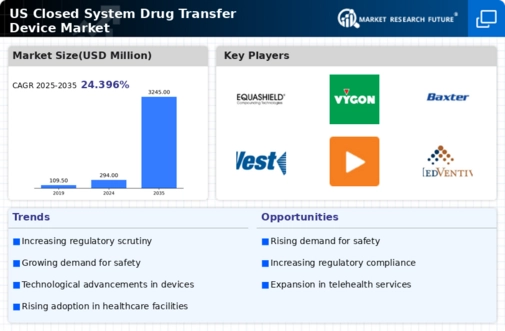Regulatory Compliance and Standards
The closed system-drug-transfer-device market is significantly shaped by the evolving landscape of regulatory compliance and standards. Regulatory bodies are increasingly enforcing stringent guidelines to ensure the safety and efficacy of drug delivery systems. This has prompted healthcare facilities to adopt closed system-drug-transfer devices that comply with these regulations, thereby enhancing patient safety. The market is projected to expand as facilities invest in compliant solutions, with an estimated growth rate of 7% over the next five years. The closed system-drug-transfer-device market is thus positioned to thrive as adherence to regulatory standards becomes a critical factor in purchasing decisions.
Rising Incidence of Chronic Diseases
The closed system-drug-transfer-device market is significantly influenced by the rising incidence of chronic diseases, which necessitates the frequent administration of hazardous drugs. Conditions such as cancer, diabetes, and autoimmune disorders require ongoing treatment regimens that often involve potent medications. As the prevalence of these diseases continues to rise, healthcare providers are increasingly turning to closed system-drug-transfer devices to ensure safe drug handling and administration. The market is expected to reach a valuation of $1 billion by 2026, reflecting the urgent need for effective drug delivery systems. This trend underscores the critical role that the closed system-drug-transfer-device market plays in addressing the challenges posed by chronic disease management.
Growing Awareness of Occupational Hazards
The closed system-drug-transfer-device market is benefiting from the growing awareness of occupational hazards associated with drug handling in healthcare environments. Healthcare professionals are increasingly cognizant of the risks posed by exposure to hazardous drugs, leading to a demand for safer handling solutions. This awareness is driving the adoption of closed system-drug-transfer devices, which are designed to minimize exposure and protect healthcare workers. The market is anticipated to grow by approximately 9% annually as organizations prioritize employee safety and well-being. The closed system-drug-transfer-device market is thus likely to see sustained growth as awareness of occupational hazards continues to influence purchasing behaviors.
Increasing Demand for Safety in Healthcare
The closed system-drug-transfer-device market experiences a notable surge in demand driven by the increasing emphasis on safety protocols within healthcare settings. Hospitals and clinics are prioritizing the reduction of exposure to hazardous drugs, which has led to a growing adoption of closed system-drug-transfer devices. According to recent data, the market is projected to grow at a CAGR of approximately 8% over the next five years. This trend reflects a broader commitment to patient and healthcare worker safety, as well as compliance with stringent regulations. The closed system-drug-transfer-device market is thus positioned to benefit from this heightened focus on safety, as healthcare facilities seek to implement solutions that minimize risk and enhance operational efficiency.
Technological Integration in Drug Delivery Systems
The closed system-drug-transfer-device market is witnessing a transformative shift due to the integration of advanced technologies in drug delivery systems. Innovations such as smart devices and automated systems are enhancing the efficiency and safety of drug transfer processes. This technological evolution is likely to attract investments, with the market projected to grow by 10% annually over the next few years. The closed system-drug-transfer-device market is adapting to these advancements, as manufacturers strive to develop products that not only meet regulatory standards but also incorporate user-friendly features. This integration of technology is expected to streamline operations and improve patient outcomes, thereby driving market growth.




















Leave a Comment